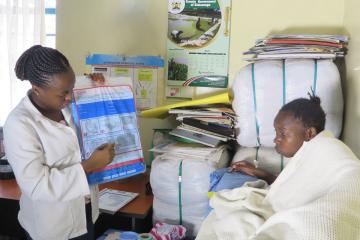
Encouraging adherence to preventive health guidelines during a pandemic: Lessons from rigorous Covid-19 evidence

Please note: This document was initially prepared by the J-PAL Health Sector in 2020 and updated in 2021 and again in 2022 to provide recommendations for responding to the Covid-19 pandemic. It is not an exhaustive review of all the rigorous evidence on the discussed topics.
Last updated: November 2022.
Throughout the duration of the novel coronavirus 2019 (Covid-19) pandemic the World Health Organization (WHO), national health agencies, and other experts have issued guidance on measures to prevent Covid-19 infection such as practicing social distancing, wearing a mask, and handwashing frequently. However, following this guidance has not always feasible for everyone. Individuals living in overcrowded conditions may not be able to practice social distancing, those whose livelihoods depend on frequent and close interactions with others may not be able to afford avoiding these activities, and those without access to clean water and soap may not be able to wash their hands frequently.
Other individuals may not be aware of the guidelines, may not understand the specific steps to follow, or they may not be convinced of the need to practice these behaviors. Misinformation about Covid-19 and its vaccines has also undermined public health guidelines and trust in health systems. In instances where lack of clear messaging or inadequate understanding of the need to practice recommended behaviors are the primary barriers to guideline adherence, evidence from rigorous research can help to inform government actions. Such evidence can be similarly helpful in areas where preventive vaccines are more readily available, but lack of information or presence of misinformation are the main constraints to uptake.
This note provides an overview of the evidence from randomized evaluations that has come out during the Covid-19 pandemic thus far to combat these barriers. These general lessons on increasing uptake of healthy behaviors and improving the delivery of health products and services may be of value in informing future outbreak response. For lessons specific to increasing the reach and uptake of vaccines, please see the brief available here.
This note does not tailor recommendations to specific contexts or provide details on implementation. Rather, we encourage policymakers to reach out to Emily Blagg (eblagg@povertyactionlab.org), J-PAL Health Sector Senior Policy Associate, for follow-up conversations on incorporating the evidence into policy decisions.
Designing information campaigns to increase uptake of preventive behaviors
Many governments, especially at the onset of the Covid-19 pandemic, advised residents to stay home, practice social distancing, regularly wash hands, and take various other actions to prevent Covid-19. In future outbreaks, it is likely that many individuals will similarly find it challenging to regularly practice recommended behaviors like these due to financial insecurity, lack of access to clean water or soap, and other constraints. For those who are physically able to take up these behaviors, what information is shared, how it is shared, and through whom may influence adherence, particularly if the information is new or rapidly evolving.
Evidence on behavior change campaigns shows that framing information in a specific and actionable way is important. Carefully considering the messengers who convey the messages and the platforms through which this information is disseminated are also essential for increasing the reach of public health messages and combating misinformation.
Framing information in an effective manner is essential for changing behaviors.
Implement specific and actionable information campaigns to encourage key preventive behaviors. A large body of evidence1 from around the world shows that simply urging people to change behavior usually does not work. Rather, policymakers may find it beneficial to issue specific information on what behaviors to take up and why these actions are important, particularly when introducing new recommendations. For example, when recommending handwashing, policymaker advice to wash hands upon returning from the grocery store or to set an alarm to remember to wash hands every two hours is likely to be more effective than more general exhortation to “wash hands regularly.” Likewise, encouragement to replace handshakes with head nods or elbow bumps may be more actionable than simply telling individuals to avoid handshakes.
Covid-19 research
Three studies from the J-PAL network provide evidence that specific and actionable information can indeed also change Covid-19 preventive behaviors.
- In India,2 individuals received short, 2.5-minute video clips in 2020, in which a well-known individual provided specific, actionable information on how to identify Covid-19 symptoms and how to report them to frontline health workers. They also received information on Covid-19 preventive behaviors and how and why to adopt them. These videos led individuals to reduce travel, increase self-reported handwashing, and doubled symptom reporting rates to community health workers.
- In the United States,3 people tended to underestimate disease risk to elderly people. Providing information in 2020 on elderly individuals’ actual probability of death led participants to overcome their initial perceptions, watch more videos on protecting others, and, when prompted, were more likely to donate to the US Centers for Disease Control and Prevention’s (CDC) Emergency Fund to fight Covid-19.
- In Bangladesh,4 a package of interventions included mask promoters in public areas who regularly provided information on the importance of wearing masks. Regularly providing this information also helped to reinforce it, which was an important component of increasing observed correct mask-wearing over a ten-week period.
The platform through which information is spread is an important consideration. Edutainment can be effective, as can different social media platforms.
Where possible, incorporate key public health messages into new or existing entertainment media (or “edutainment”) to help improve adherence to recommended behaviors. Media such as television, radio, or other entertainment platforms can be used to change attitudes and behaviors by embedding educational messages in a bigger storyline.5 As people around the world have spent more time at home during the Covid-19 pandemic, the ability to identify with characters facing similar changes to their personal life may have further underscored edutainment’s potential to influence individual behavior.
Relevant research
While J-PAL affiliates have not yet studied edutainment in a Covid-19 context, studies from before the pandemic demonstrate the impact of edutainment on behaviors.6 For example, in Nigeria,7 the edutainment television series MTV Shuga improved knowledge and attitudes towards HIV and risky sexual behavior and increased the likelihood of getting tested for HIV. Effects were stronger for viewers who reported being more involved with the story or identified with the characters.
Social media like Twitter and Facebook can be a powerful delivery platform to share key public health messages and combat misinformation. Such social media sites have become a vital part of information-sharing in the 21st century, and evidence shows that leveraging them can be an effective means of amplifying messages to shift beliefs and behaviors.8 This is particularly true when the messenger is effective and information is framed in a specific and actionable manner. Because they can also be a source of misinformation, monitoring online platforms such as Facebook, Twitter, WhatsApp, and others for false messages can help identify situations where correcting misconceptions can be particularly important.
Covid-19 research
Three studies from J-PAL affiliates and invited researchers show the importance of leveraging social media during Covid-19, both to share information on important preventive behaviors and to combat misinformation.
- In Zimbabwe,9 a local civil society organization sent WhatsApp messages to their newsletter subscribers to convey truthful information about Covid-19 and to debunk misinformation about fake cures. These messages increased knowledge about Covid-19 and reported adherence to lockdown orders.
- In India,10 users received SMS messages containing a link to videos from a credible, well-known expert advising individuals to report Covid-19 symptoms and follow local guidelines. By leveraging low-cost SMS technology, millions of people were reached with these messages that in turn increased reporting of symptoms and self-reported adherence to guidelines.
- In the United States,11 videos of physicians posted on Facebook encouraged users to stay home for the Thanksgiving and Christmas holidays. These videos, which were viewed by more than 35 million people, were effective in reducing travel for the three days before each holiday.
These messages may have been effective in part because they came from a known and respected source or because they came early in the pandemic, before beliefs and practices became more entrenched.
- Another study in India,12 taking place between mid-August and mid-October 2020, sent SMS messages to households in Bihar. In total, ten different messages were tested, which either encouraged the recipient to adopt social distancing or hand washing. What varied was the framing of the information and when in the day the message was sent. None of these approaches improved knowledge or adoption of distancing and handwashing.
While SMS messages containing information or advice may not always be effective, as found in this study from Bihar, other studies such as the one from West Bengal indicate that they can have an impact. Because SMS-based messaging is low cost, it may be worth implementing it, particularly if implemented alongside other interventions mentioned in this note.
Evidence on information provision demonstrates that receiving messages from those with whom one feels a connection—community members, peers, characters on TV shows and other forms of entertainment, celebrities, etc.—can be important for uptake of recommended behaviors. Messaging this information with specific and actionable steps can be additionally impactful, while leveraging platforms such as social media can help to widely disseminate information.
Choosing effective messengers is critical for changing behavior. Social networks, peers, and celebrities can all be effective at spreading information.
Directly leverage the influence of well-connected community members and peers (while avoiding face-to-face interactions as needed) to help spread accurate information on new recommendations. While top-down messaging that is framed in a specific and actionable way can change behavior, studies from around the world have found that leveraging the community is also important for sustained behavior change. Where guidelines on social distancing may make in-person interactions difficult or inadvisable, online and mobile platforms can be good ways to leverage this influence.
Covid-19 research
Five studies from J-PAL affiliates provide further evidence on the impact of peer and social networks on behavior change for Covid-19 prevention.
- In India,14 providing information on Covid-19 prevention and symptom reporting through short videos increased self-reported adherence to Covid-19 preventive behaviors by those receiving links to the videos as well as by their neighbors at roughly the same rate. The messages did not increase conversations about Covid-19. This suggests that behavior change among non-recipients was due to neighbors directly observing and imitating the behavior changes among those who did receive the messages.
- In the United States,15 role models impacted donations to the US Center for Disease Control and Prevention’s (CDC) Emergency Fund to fight Covid-19. Participants who read messages and watched videos about the behavior of fellow citizens were more likely to emulate those actions. For instance, learning that other Americans were volunteering or donating to the CDC made participants more likely to learn about volunteering or to donate to the CDC.
- In Mozambique,16 informing people about high local community support for social distancing had different impacts based on local Covid-19 infection rates. Where infection rates were high, providing this information caused individuals to increase social distancing. But where rates were low, the information caused social distancing to drop. Additionally, local leader endorsements of social distancing had no effect on behavior.
- In Bangladesh,17 information on Covid-19 symptoms and preventive measures in addition to mental health support was provided to women via low-cost, private telecounseling sessions with female para-counselors. Para-counselors were locally recruited, trained using context-specific information modules, and had a good general understanding of women’s lives in the context. These sessions with a trustworthy source were effective in increasing self-reported compliance with preventive behaviors and self-reported vaccination.
- Zambia,18 peers were willing to share messages via SMS about preventive pro-social behavior with their social networks after receiving suggestions to do so, but financial incentives did not increase the likelihood they would forward messages. Additionally, neither incentivized nor non-incentivized encouragement to share messages had any change on self-reported health behaviors among peers or their social networks.
Educating celebrities early on in an epidemic and leveraging their voices can help to increase the reach of public health messages and avoid the spread of misinformation. Depending on the content and accuracy of their message, all individuals with a media following can have a positive or negative impact on public opinion and behavior. Celebrity endorsement or information-sharing may be particularly powerful when celebrities speak in their own voice.
Covid-19 research
Two studies by J-PAL affiliates support the recommendation that hearing directly from celebrities can shift behavior around Covid-19.
- In West Bengal, India,20 participants received 2.5-minute videos on Covid-19 prevention featuring Abhijit Banerjee, a well-known intellectual from West Bengal. In the videos, Abhijit Banerjee instructed individuals to report any Covid-19 symptoms to health workers and emphasized why adopting preventive behaviors is important. The videos doubled symptom reporting to community health workers and increased self-reported adherence to other preventive behaviors such as mask-wearing, handwashing, and reduced travel.
- In Bangladesh,21 mask-wearing was legally required in public areas, but compliance was low. As part of a larger set of interventions designed to increase mask usage, participants viewed short videos on the importance of mask-wearing from public figures like the Prime Minister, a religious leader, or a national cricket star. This information, combined with interventions including free mask provision and active mask promotion, was effective at increasing correct mask-wearing.
Note that, to date, this recommendation on celebrity endorsement is based on three studies22 rather than a broader body of research.
Building trust in health systems
Programs or policies that increase trust in the health system could improve reporting and cooperation with health guidelines, which in turn could help increase testing, reduce the spread of the disease, and reduce mortality.
Implement interventions that increase trust in health systems. What interventions are effective can vary based on context. Improving perceptions of quality may be effective in some areas, while ensuring patients see doctors whom they trust may be more important in others. Such interventions may be most impactful in areas with low baseline utilization of health care services or amongst populations with low levels of trust in the health system (including marginalized groups that may include migrants, LGBTQ individuals, indigenous communities, or racial minorities depending on the context). Additional trust-building policies, such as ensuring patient confidentiality with regard to immigration status, could also help address wariness of the formal health system. Such measures would likely improve the resiliency of the health systems over time; they may also possibly improve outcomes if implemented during or right before a major health shock, though this has not been studied to date.
Covid-19 research
Establishing trust that is not already present can be difficult. For instance, following an analysis that found that those who trusted the police were more likely to comply with Covid-19 restrictions, a study from Uganda23 tested the impact of a new community policing program that aimed to improve relationships between the police and the community. The program only slightly increased trust in the police, and it had no impact on adherence to health guidelines.
As discussed above, leveraging the voice of messengers who are trusted by the audience is important for increasing adherence to guidelines. However, who these trusted messengers are will likely change across contexts. Three studies by J-PAL affiliates highlight messenger characteristics that may be especially important in the United States to change behavior and increase adherence to preventive guidelines and uptake of vaccines. A fourth study across twelve Latin American countries further highlights the context-specific nature of trusted messengers.
- Black and Latino adults received videos from physicians conveying information about Covid-19 and the importance of preventive behaviors.24 Viewing a message from any physician increased knowledge of Covid-19 symptoms and prevention. Black adults—who have historically faced discrimination in the health system—who viewed a video from a Black physician were also more likely to rate the video as being more informative and trustworthy and to self-report increased take-up of Covid-19 preventive behaviors relative to those who watched a video of a physician of another race. There was no consistent effect among Latino participants who viewed videos by Latino physicians.
- However, while race concordance may be important, it is not always necessarily a driving factor. Another study in the United States25 found that messages delivered by physicians increased knowledge about Covid-19 and use of preventative health measures, like mask-wearing and social distancing, regardless of recipients’ race or political beliefs.
- Health messengers can also be laypeople, rather than physicians or other experts.26 In particular, those who were least willing to become vaccinated were more likely to report willingness to get the Covid-19 vaccines when they received information from laypeople, rather than from medical experts.
- Across twelve Latin American countries27 attributing health recommendations to an expert (regardless of whether an academic, public, or private sector expert) led to lower agreement with advice specific to Covid-19, but not for other general health recommendations. In particular, individuals with low levels of trust in experts prior to the intervention had lower levels of agreement with all recommendations as compared to those who tend to trust experts. This backlash may also impact intended compliance with recommendations.
Leveraging cash transfers to increase uptake of preventive behaviors
Since a health crisis may be accompanied by a severe economic one, cash transfers can provide income support and potentially increase uptake of healthy behaviors.
Leverage cash transfers, especially those conditioned on uptake of Covid-19 preventive behaviors, to improve prevention. Unconditional transfers can provide income support. While both conditional and unconditional transfers have costs associated with determining eligibility, targeting the transfer to intended households, and delivering the cash, a review of the literature28 shows that cash transfers conditioned on certain behaviors increase take-up of those behaviors. Cash transfers with no conditions increase spending on overall household priorities and improves general well-being. Policymakers may consider the outcome(s) they are hoping to achieve, as well as the relative costs and benefits of each type of transfer across all target outcomes, when determining which transfer to implement.
Covid-19 research
Two studies by J-PAL affiliates found that cash transfers improved several indicators of household well-being, including in health, and increased self-reported adherence to preventive measures during the Covid-19 pandemic.
- In Kenya,29 households received universal basic income during Covid-19. These cash transfers effectively reduced hunger, sickness, and depression in spite of the pandemic. They also reduced hospital visits and decreased reported social interactions.
- In Ghana,30 households received mobile money transfers, along with messages about safe pandemic practices, to help lessen the economic impacts of Covid-19 and increase adherence. While the announcement of these transfers had no effect on social distancing, once disbursed, self-reported compliance with social distancing did increase. Transfers also increased spending on food.
Improving the delivery of health products and services
The practices described above can help motivate individuals and households to take up healthy behaviors. However, take-up of preventive commodities is only possible if they are readily available and easily accessible. As governments and other actors think through distribution of essential commodities once they are developed, research yields insights on how to deliver them to maximize uptake and encourage adherence to guidelines.
When feasible, subsidizing recommended preventive health products and eliminating user fees can increase uptake. Uptake of preventive health products, such as vaccines, is highly sensitive to price. A review of more than 15 studies from around the world31 shows that take-up reduces dramatically even with small price increases, and especially so for products with large social externalities. Making protective masks, tests, soap, and other preventive commodities free of charge can help to ensure increased uptake. This is also important for ensuring take-up of vaccines and treatments.
Covid-19 research
One study by J-PAL affiliates shows the importance of free distribution on increasing uptake during the Covid-19 pandemic.
- In Bangladesh,32 individuals who received preventive masks for free as a part of a package of demand-generating interventions that also included regular reminders were more likely to use them—and to do so correctly—than those not receiving this package. Adding other financial interventions such as cash incentives to wear masks had no additional impact.
Other considerations
In addition to common feasibility and information constraints that may hinder adherence to guidelines, evidence also points to the emerging role mental health and stigma may have in impacting ability to adhere.
The health and social impacts and economic disruption caused by Covid-19 have increased the prevalence of mental health illnesses, especially among vulnerable groups in poverty. The stigma associated with being infected or being suspected as more likely to be infected can lead to harmful discrimination and negatively impact mental health in addition to discouraging compliance with public health guidelines. Stigma and discrimination can arise from a lack of knowledge and fear.
Covid-19 research
Four studies by J-PAL affiliates highlight other important elements, like mental health and stigma, to keep in mind when considering barriers to adherence to preventive behaviors.
- In Bangladesh,33 over-the-phone counseling aimed at mitigating the mental health impact of Covid-19 included a session on Covid-19 symptoms and recommended preventive measures to address fear of infection resulting in improved preventive health behavior. The overall intervention also improved mental health with reductions in self-reported stress and depression levels.
- In India,34 providing accurate and focused information from a reliable source decreased stigmatization and discrimination, and decreased the likelihood that participants wrongly assume infection cases are more prevalent among certain demographic and social economic groups. As a result, it increased compliance with social distancing recommendations and knowledge of prevention.
- In another study in India,35 informational phone calls led to increases in Covid-19 related knowledge and also reduced depression and anxiety. However, these improvements in mental health were not due to the information provided by the phone calls, but because a real person was delivering the information by phone.
- Many individuals may have incorrect prior beliefs about Covid-19. In the US and UK,36 providing individuals with expert information can update and correct their beliefs in the short-term. However, increasing the perceived infectiousness makes individuals more fatalistic and less willing to adhere to recommended protective behaviors.
This note highlights some general lessons on how policymakers may be able to increase adherence to Covid-19 guidelines and improve the delivery of key health products. It does not intend to provide details on implementation. Policymakers interested in learning more about the evidence presented here are encouraged to reach out to Emily Blagg (eblagg@povertyactionlab.org), J-PAL Health Sector Senior Policy Associate, for follow-up conversations on incorporating the evidence into policy decisions.
Footnotes
1 See J-PAL Policy Insight here.
2 Banerjee et al, 2020
3 Abel et al 2021
4 Abaluck et al 2021
5 J-PAL’s Policy Insight containing evidence on edutainment is available here.
6 J-PAL’s Policy Insight containing evidence on edutainment is available here.
7 Banerjee et al. 2019
8 Alatas et al. 2021; Banerjee et al, 2020; Bowles et al. 2020
9 Bowles et al. 2020
10 Banerjee et al, 2020
11 Breza et al. 2021
12 Bahety et al. 2021
13 J-PAL’s Policy Insight containing evidence on leveraging peer effects and social networks for health is here.
14 Banerjee et al, 2020
15 Abel and Brown 2020
16 Allen et al. 2021
17 Vlassopoulos et al. 2022
18 Burlando et al. 2022
19 Alatas et al. 2021; Banerjee et al, 2020
20 Banerjee et al, 2020
21 Abaluck et al. 2021
22 Alatas et al. 2020; Banerjee et al, 2020; Abaluck et al. 2021
23 Blair et al. 2021
24 Alsan et al. 2021
25 Torres et al. 2021
26 Alsan and Eichmeyer 2021
27 Albornoz et al. 2022
28 J-PAL’s policy insight on the topic is available here.
29 Banerjee et al. 2020
30 Karlan et al. 2022
31 J-PAL’s policy insight on the topic is available here.
32 Abaluck et al. 2021
33 Vlassopoulos et al. 2022
34 Islam et al. 2021
35 Sadish et al. 2021
36 Akesson et al. 2021





